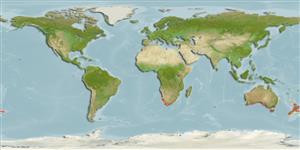>
Eupercaria/misc (Various families in series Eupercaria) >
Emmelichthyidae (Rovers)
Etymology: Plagiogeneion: Greek, plagios = oblique + Greek, geny, genyos, diminutive = face (Ref. 45335).
Environment: milieu / climate zone / rango de profundidad / distribution range
Ecología
marino batidemersal; rango de profundidad 30 - 600 m (Ref. 106682). Deep-water; 22°S - 40°S, 14°E - 170°E
Southeast Atlantic: Vema Seamount west of Cape Town and off Algoa Bay, and Walvis Bay in Namibia. Southern Indo-West Pacific: St. Paul and Amsterdam Islands, southern Australia, and New Zealand.
Tamaño / Peso / Age
Madurez: Lm ? range ? - ? cm
Max length : 60.0 cm TL macho / no sexado; (Ref. 5325); common length : 40.0 cm TL macho / no sexado; (Ref. 115123); edad máxima reportada: 10 años (Ref. 35378)
Short description
Claves de identificación | Morfología | Morfometría
Espinas dorsales (total) : 12; Radios blandos dorsales (total) : 10 - 12; Espinas anales: 3; Radios blandos anales: 10. Rosy pink in color, brownish dorsally, silvery below; fins red, tips of caudal fin blackish (Ref. 5325).
Body shape (shape guide): fusiform / normal.
Adults occur near sandy or muddy bottom in deep water. Feeds on larger zooplankton (Ref. 3394). Marketed fresh or frozen and proves to be an excellent foodfish (Ref. 115123).
Life cycle and mating behavior
Madurez | Reproducción | Puesta | Huevos | Fecundidad | Larva
Heemstra, P.C., 2016. Emmelichthyidae. pp. 2526-2533. In K.E. Carpenter and N. De Angelis (eds.). The living marine resources of the Eastern Central Atlantic. Vol. 4: Bony fishes part 2 (Perciformes to Tetradontiformes) and sea turtles. FAO Species Identification Guide for Fishery Purposes, Rome, FAO. pp. 2343-3124. (Ref. 115123)
IUCN Red List Status (Ref. 130435: Version 2025-1)
Threat to humans
Harmless
Human uses
Pesquerías: comercial
Herramientas
Special reports
Download XML
Fuentes de Internet
Estimates based on models
Preferred temperature (Referencia
123201): 9 - 19.7, mean 14.2 °C (based on 63 cells).
Phylogenetic diversity index (Referencia
82804): PD
50 = 0.5313 [Uniqueness, from 0.5 = low to 2.0 = high].
Bayesian length-weight: a=0.01072 (0.00491 - 0.02339), b=3.07 (2.87 - 3.27), in cm total length, based on LWR estimates for this species & (Sub)family-body (Ref.
93245).
Nivel trófico (Referencia
69278): 3.4 ±0.45 se; based on food items.
Generation time: 3.7 ( na - na) years. Estimated as median ln(3)/K based on 1
growth studies.
Resiliencia (Referencia
120179): Medio, población duplicada en un tiempo mínimo de 1.4-4.4 años (tmax=10; K=0.33; tm=3-4).
Fishing Vulnerability (Ref.
59153): Moderate vulnerability (41 of 100).
🛈
Nutrients (Ref.
124155): Calcium = 24 [15, 56] mg/100g; Iron = 0.518 [0.212, 0.995] mg/100g; Protein = 17.8 [16.8, 18.7] %; Omega3 = 0.365 [0.214, 0.620] g/100g; Selenium = 18.2 [8.0, 38.5] μg/100g; VitaminA = 11.7 [2.7, 51.2] μg/100g; Zinc = 0.367 [0.255, 0.547] mg/100g (wet weight);
